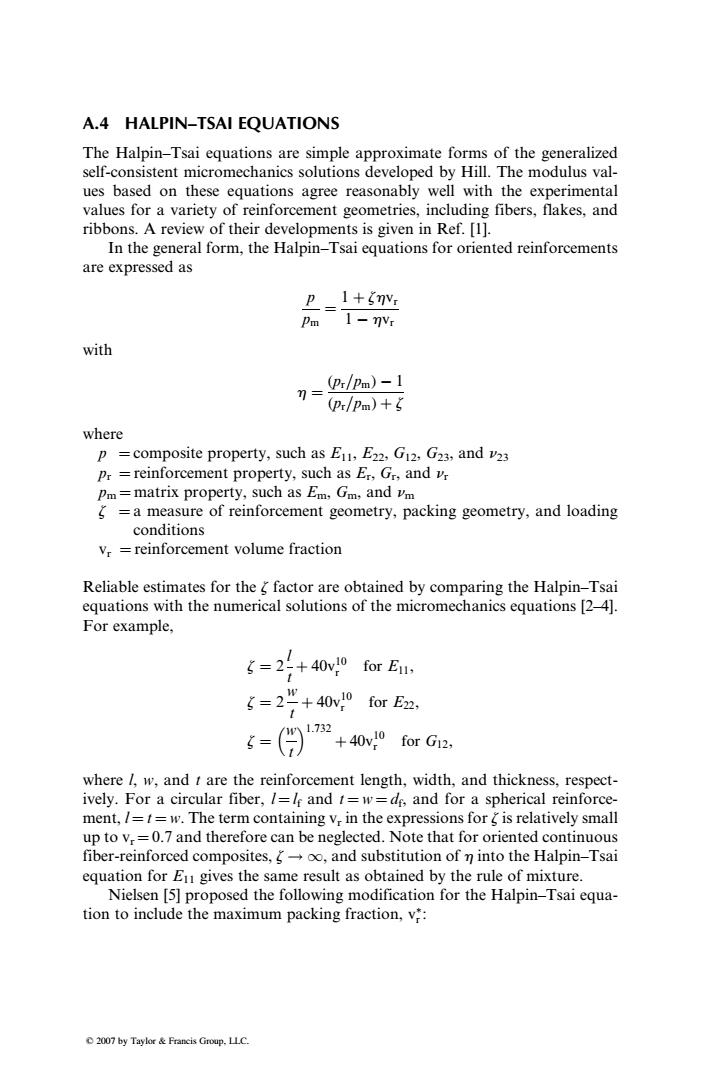正在加载图片...

A.4 HALPIN-TSAI EQUATIONS The Halpin-Tsai equations are simple approximate forms of the generalized self-consistent micromechanics solutions developed by Hill.The modulus val- ues based on these equations agree reasonably well with the experimental values for a variety of reinforcement geometries,including fibers,flakes,and ribbons.A review of their developments is given in Ref.[1]. In the general form,the Halpin-Tsai equations for oriented reinforcements are expressed as p1+5nvr a=1- with n=/pm)-1 (pr/pm)+5 where p =composite property,such as E11,E22,G12,G23,and v23 Pr =reinforcement property,such as Er,Gr,and v Pm=matrix property,such as Em,Gm,and vm =a measure of reinforcement geometry,packing geometry,and loading conditions Vr =reinforcement volume fraction Reliable estimates for the factor are obtained by comparing the Halpin-Tsai equations with the numerical solutions of the micromechanics equations [2-4]. For example, =2+40v10 for Eu. g=2”+40v40 forE22, -(月m +40v10 for G12, where /w,and t are the reinforcement length,width,and thickness,respect- ively.For a circular fiber,/=le and t=w=de,and for a spherical reinforce- ment,/=t=w.The term containing v in the expressions for is relatively small up to v=0.7 and therefore can be neglected.Note that for oriented continuous fiber-reinforced composites,-oo,and substitution of n into the Halpin-Tsai equation for Eu gives the same result as obtained by the rule of mixture. Nielsen [5]proposed the following modification for the Halpin-Tsai equa- tion to include the maximum packing fraction,v*: 2007 by Taylor&Francis Group.LLC.A.4 HALPIN–TSAI EQUATIONS The Halpin–Tsai equations are simple approximate forms of the generalized self-consistent micromechanics solutions developed by Hill. The modulus values based on these equations agree reasonably well with the experimental values for a variety of reinforcement geometries, including fibers, flakes, and ribbons. A review of their developments is given in Ref. [1]. In the general form, the Halpin–Tsai equations for oriented reinforcements are expressed as p pm ¼ 1 þ zhvr 1 hvr with h ¼ (pr=pm) 1 (pr=pm) þ z where p ¼ composite property, such as E11, E22, G12, G23, and n23 pr ¼ reinforcement property, such as Er, Gr, and nr pm ¼ matrix property, such as Em, Gm, and nm z ¼ a measure of reinforcement geometry, packing geometry, and loading conditions vr ¼ reinforcement volume fraction Reliable estimates for the z factor are obtained by comparing the Halpin–Tsai equations with the numerical solutions of the micromechanics equations [2–4]. For example, z ¼ 2 l t þ 40v10 r for E11, z ¼ 2 w t þ 40v10 r for E22, z ¼ w t 1:732 þ 40v10 r for G12, where l, w, and t are the reinforcement length, width, and thickness, respectively. For a circular fiber, l ¼ lf and t ¼ w ¼ df, and for a spherical reinforcement, l ¼ t ¼ w. The term containing vr in the expressions for z is relatively small up to vr ¼ 0.7 and therefore can be neglected. Note that for oriented continuous fiber-reinforced composites, z ! 1, and substitution of h into the Halpin–Tsai equation for E11 gives the same result as obtained by the rule of mixture. Nielsen [5] proposed the following modification for the Halpin–Tsai equation to include the maximum packing fraction, v r : 2007 by Taylor & Francis Group, LLC.�